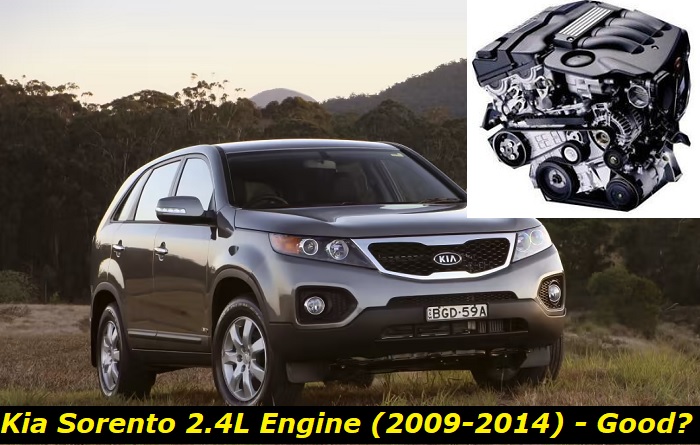The 2009-2014 Kia Sorento 2.4L engine had a lot of promising features for buyers. Considering that it was manufactured by Hyundai which held quite a reputation for its quality of work over the years, it simply failed to meet expectations.
The engine was infamous for having a lot of serious issues, which were proven in court and some of the problems were even openly acknowledged by its manufacturer. In this article, we will expose the overall quality of the engine to help any unsuspecting buyers and owners as to what they may run into.

Key facts and my opinion about the engine
- Production years: 2008-2019
- Average lifespan of G4KE: 190,000-210,000 miles
- Fuel supply type: port injection
- Power range: 170-180 hp
- Fuel efficiency: good
- Engine block material: aluminum
- Engine reliability score: medium
- The most common problems: cylinder warping, weak timing chain, rod bearings premature death, oil leaks.
2009-2014 KIA Sorento 2.4L Engine Longevity
For people who have experienced the worst out of their 2009 to 2014 Kia Sorento 2.4L engines (G4KE), they may tell you to stay away from it completely. We fact-checked their claims and it has led us to discover serious issues occurring in the engine as early as their 10,000-mile run.
Even with careful maintenance, you would be lucky to get it to 62,000 miles without needing major parts replacement arising from the problems that we are about to show you in the next section of this article.
Most Common Problems Linked to the 2009-2014 KIA Sorento 2.4L Engine
There are numerous problems associated with the 2009-2014 KIA Sorento 2.4L engine. Most of them are connected to engine failures. According to consumer reports and reviews about the power unit, as well as common knowledge about related Kia engines, here are the most common issues that eventually lead to such a scenario:
1. Excessive Oil Consumption
Oil consumption can vary depending on how you use your car. For example, if you mainly drive in stop-and-go traffic, your car will consume more oil than if you mostly cruise on the highway. The deterioration of parts due to age is another natural cause of this. However, there is specific stuff in the Kia Sorento that can cause excessive oil consumption, and it's important to be aware of them before they result in engine failure.
A common cause of excessive oil consumption in the 2.4L engine of the 2009-2014 Sorento is worn piston rings. When your piston rings are worn, they no longer provide a good seal between the piston and the cylinder wall. This can allow oil to enter the combustion chamber and get burned along with the fuel. You might notice this problem if your car is using more oil than usual, or if it's smoking excessively from the tailpipe.
Another possible cause of excessive oil consumption in the Sorento is a leaking valve seal. The valve seal sits on top of the valve and prevents oil from entering the combustion chamber. If the seal is damaged or worn, it can allow oil to leak past it and into the combustion chamber. This can also lead to increased oil consumption and tailpipe smoke. Remember to inspect the hoses and gaskets, too, while you're at it.
Excessive oil consumption can spell a lot of trouble for a vehicle. It can mainly lead to lubrication issues that can quickly wear out the moving parts of your engine. The lubrication issues and worn parts will then increase the risk of overheating in some areas of your vehicle, which can lead to the write-off of your engine, fire, or accidents.
If you notice that your car is consuming more oil than usual, or if it's smoking from the tailpipe, it's important to have it checked out by a mechanic. In some cases, they may suggest replacing the piston rings or valve seal. However, if the problem is severe, they may tell you to rebuild or replace the engine altogether.
2. Carbon Build-Up
Carbon build-up is fairly common in an old vehicle. Considering that the 2.4L Sorento engine version we are talking about here is already around 8 to 13 years old, expect to run into this kind of problem if you are buying a 2009 to 2014 model of the SUV in the used car market or if you are already a long-term owner of the unit.
There are reports that even when they were almost brand new, the Sorento 2.4L engine was already prone to this problem. The concentration of the deposits is usually found in the intake ports and valves. This is due to the fact that the fuel injectors are placed further away from these areas in this particular engine version.
The good news is that there are products available in the market now that are particularly designed to clean up carbon deposits without necessarily disassembling the engine. You can use these cleaners by pouring them into the gas tank and then running the engine at idle for about 30 minutes to an hour. Doing this regularly will help prevent the problem from getting worse.
If you are already experiencing some of the symptoms related to excessive oil consumption, then it is likely that your 2.4L Sorento engine has developed a carbon build-up. These symptoms include a decrease in fuel economy, loss of power, and increased oil consumption.
You can easily spot the problem through visual signs of leaks or dirt accumulation. An alternative is via a compression test. The latter will help you determine if the rings and valves are already affected by the carbon build-up. If the results of the compression test are normal, then the next step is to do a leak-down test. This will identify any leaking valves that may be contributing to the oil consumption problem.
Once you have determined that there is indeed a carbon build-up problem, the next step is to address it accordingly. There are several ways to do this, but the most common and effective solution is to have a cleaning fluid poured into it as mentioned. If this fails, better have it professionally cleaned.
The professional cleaning process usually involves disassembling the engine and then using specialized equipment to clear out all the carbon deposits. Depending on the severity of the problem, they may utilize the method called "walnut blasting" to clean the contamination.
The process of walnut blasting involves using small pieces of walnut shells to remove the carbon deposits. This is a highly effective method, but it can be pricey. Another option is to have the valve and intake components replaced, which is obviously not ideal if you are trying to save money. In extreme cases, rebuilding or replacing may be the only solution if the contamination has already led to major damage in many of its internal components.
Whatever solution you choose, make sure that you consult with a qualified mechanic to ensure that it is the best course of action for your particular situation. Trying to fix the problem on your own without proper knowledge and expertise can often do more harm than good.
3. Engine Knocking
Knocking noises in the engine can be caused by a few different things. The most common are worn-out piston rings. When the piston rings deteriorate or get damaged, they no longer seal properly against the cylinder walls. This causes oil to leak past the rings and into the combustion chamber. As the oil ignites, it causes a knocking noise.
Another possible cause of knocking noises is a faulty or failing connecting rod bearing. Over time, these bearings can wear out and fail. When they fail, they allow the connecting rods to knock against the crankshaft, which causes a knocking noise.
Finally, knocking noises can also be caused by a faulty or failing fuel injector. The injectors can become clogged or damaged over the years as well. When this happens, they may not deliver enough fuel to the engine, which can cause knocking.
If you hear a knocking noise coming from your engine, it's important to have it diagnosed and repaired as soon as possible. Depending on the cause of the knocking, you may need to replace worn-out parts, such as piston rings or connecting rod bearings. In some cases, you may even need to replace the entire engine if the damage is already irreparable or the parts replacements are almost priced as an engine replacement. However, if you catch the problem early enough, you may be able to avoid major repairs and keep your car running smoothly.
2009-2014 KIA Sorento 2.4L Engine Specs
The second generation of the Kia Sorento made its world premiere at the New York Auto Show in 2009. Along with it came the 2.4L engine developed by Hyundai.
The 2009-2014 KIA Sorento G4KE engine features an inline-four, direct injection configuration. It is rated 192 hp at 6,300 rpm and 178 lb-ft of torque at 4,250 rpm. At its best, it can deliver up to 20 mpg and 26 mpg fuel economy in city and highway drives, respectively.
The power unit is partnered with an automatic transmission and all-wheel-drive system as a standard feature in the Sorento SUV.
Conclusion
Success stories regarding the 2009-2014 KIA Sorento 2.4L engine are scarce. Most of them were horror stories revolving around its failures.
To be on the safe side, better consider other alternatives if you are even looking to buy a version of this engine. On the other hand, if you are already an owner of the unit, better watch out for the symptoms leading to its failure and work on them right away to get yourself out from a potentially expensive repair or engine replacement.
About the authors
The CarAraC research team is composed of seasoned auto mechanics and automotive industry professionals, including individuals with advanced degrees and certifications in their field. Our team members boast prestigious credentials, reflecting their extensive knowledge and skills. These qualifications include: IMI: Institute of the Motor Industry, ASE-Certified Master Automobile Technicians; Coventry University, Graduate of MA in Automotive Journalism; Politecnico di Torino, Italy, MS Automotive Engineering; Ss. Cyril and Methodius University in Skopje, Mechanical University in Skopje; TOC Automotive College; DHA Suffa University, Department of Mechanical Engineering





Add comment